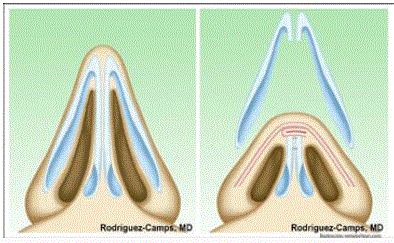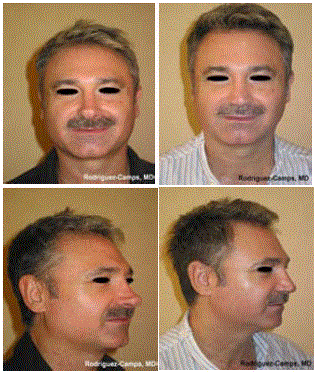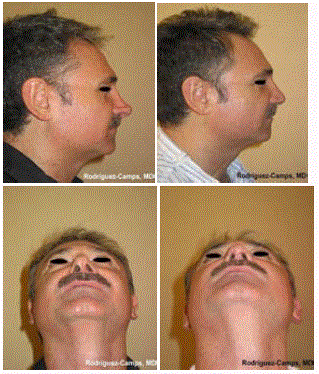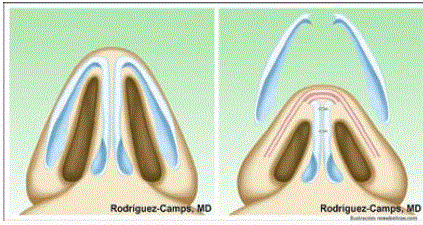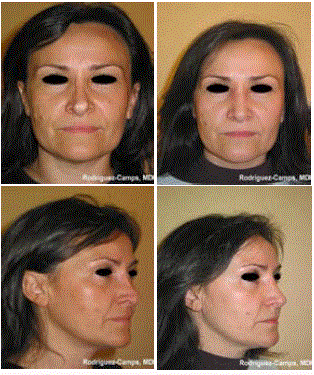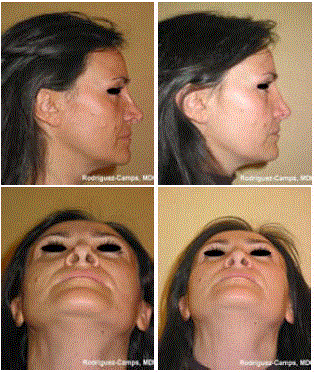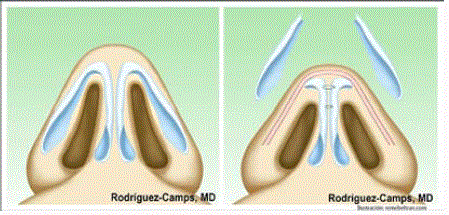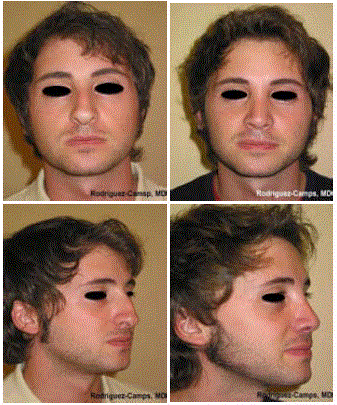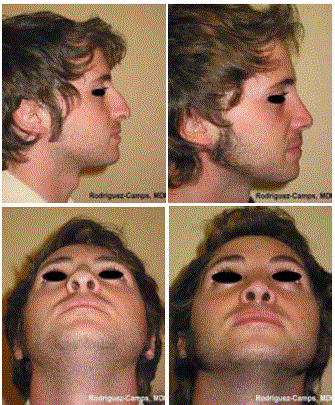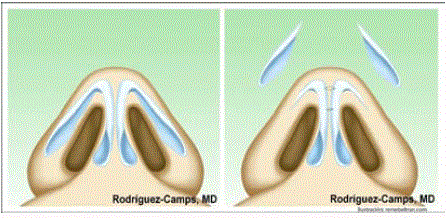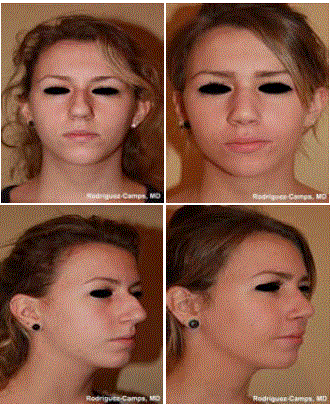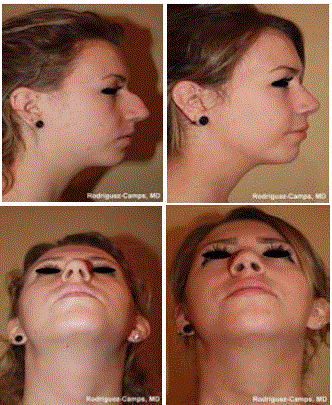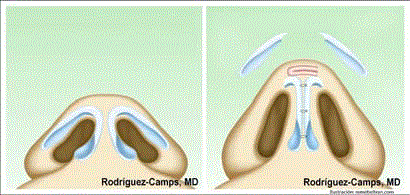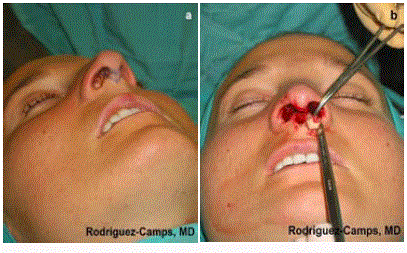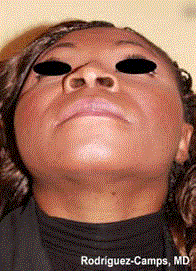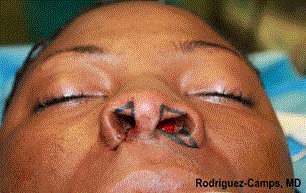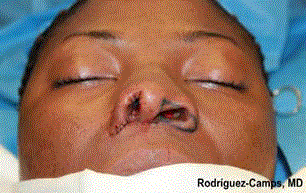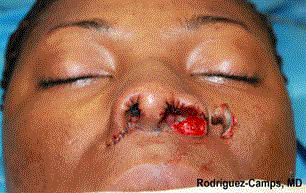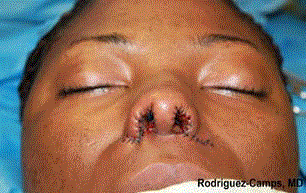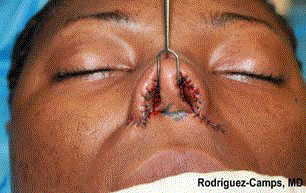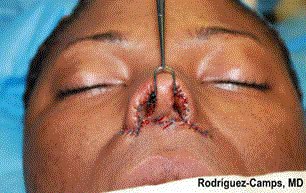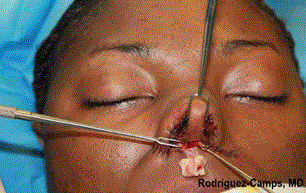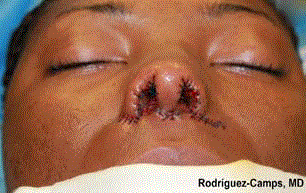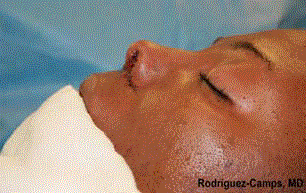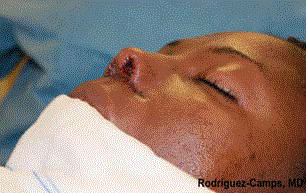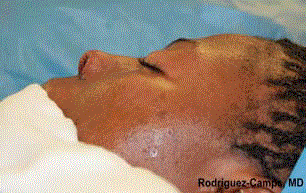Research Article
Some Less Usual, or Never Used, Technical Resources in Rhinoplasty for Nasal Base Improvement
Salvador Rodríguez-Camps*
Department of Aesthetic and Plastic Surgery, University Hospital Casa de Salud, Spain
*Corresponding author: Salvador Rodríguez-Camps, Department of the Aesthetic and Plastic Surgery, University Hospital Casa de Salud, Manuel Candela, 41. 46021 Valencia, Spain
Published: 04 Jul 2017
Cite this article as: Rodríguez-Camps S. Some Less Usual,
or Never Used, Technical Resources
in Rhinoplasty for Nasal Base
Improvement. Clin Surg. 2017; 2: 1529.
Abstract
To achieve an equilateral and stable nasal base, many technical resources have been traditionally used
that transform this vital pyramidal nasal structure into a beautiful, equilateral and stable triangle
that resists pressure on the nasal tip. Here we stress less usual resources, one of which has not yet
been published: Z-plasty in naso-labial sulcus. We stress: Columella Trunk, Soft Triangles, filling
the Nasolabial Angle, en-bloc excision of Alar and Vestibular Wedges, excision of longitudinal Alar
Bands, in the Total Resection of Alar Cartilages and Temporal Fascia, and in Z-plasty of naso-labial
sulcus. All this is done to achieve a Beautiful, Equilateral and Stable Nasal Base.
Keywords: Rhinoplasty; Nasal base; Resources in rhinoplasty; Equilateral nasal base; Z-plasty
in naso-labial sulcus
Patients and Methods
When the nasal base structure is far from ideal because it is too flat or prominent, we normally
resort to a series of technical resources to accomplish an Equilateral and Stable Nasal Base. These
resources are traditionally known, but others have hardly, or never, been used. This work focuses on
resorting to these unusual technical resources to transform an Anodyne Nasal Base into a Beautiful
one.
We commence with an important casuistry in Rhinoplasty and employ all types of technical
resources in many cases, as our Doctoral Dissertation shows: “Una Nueva Técnica de Remodelación
de la Punta Nasal en Rinoplastia, para Casos Extremadamente Difíciles, Mediante la Resección Total
de los Cartílagos Alares y Fascia Temporal” (Excellent Cum Laude).
We now provide details of the surgical sequence of some infrequently used technical resources.
Let’s go on to see what kind of technical resources have been used traditionally in Rhinoplasty
in order to improve and beautify the nasal base to transform it into an Equilateral, Beautiful and
Stable one [1-6].
- Reducing Converse Soft Triangles
- Resecting the trunk of the Septum’s Depressor Muscle
- Converse point on the columellar base
- Releasing the Columella
- Alar Wedges
- Vestibular Wedges
- Amputating Crus Medialis Feet
- Approaching Crus Medialis Feet
- Intercrus Mediales Tutor Graft
- Killian-type septoplasty [7]
- Luxation or Cauterization of Conchas
- Filling the Naso-Labial Angle with remains of Resected Cartilages wrapped
in temporal fascia
Now the time has come to talk about our personal technique to treat a difficult nasal tip by improving the nasal base at the same time and transforming it into an
Equilateral and Stable one [8-31]: Total Resection of Alar Cartilages
and Temporal Fascia, where we establish five groups which we call
Types.
• Resection type I:
Indicated for overprojecting noses with a long columella and
large and elongated nostrils.
This consists in totally amputating the alar cartilages, including
the domes and the intermedial crus trunk. Crus ends are covered with
a 2-layered temporal fascia seal and a temporal fascia layer on top.
The technical resources employed to support this technique
include: alar wedges, amputating crus medialis feet and a medial
suture of their distal ends (Figures 1,2A and 2B).
• Resection type II:
Indicated for noses with a slightly elongated base.
This operation mode is defined by completely amputating
alar cartilages, including domes, and covering them totally with a
temporal fascia seal and layer Conclusion(Figures 3,4A and 4B).
• Resection type III:
Indicated for nose heights that come very close to the ideal
equilateral nasal base objective.
The technical foundations are summarized as completely
amputating alar cartilages, but respecting domes and covering them
with a layer of temporal fascia (Figures 5,6A and 6B).
• Resection type IV:
Indicated for patients with an adequate nasal base height,
but who require tip remodeling due to possible anatomical alterations,
such as: bulbous tip, squared tip, irregular dome, asymmetries, caudal
rotation, etc.
Technically speaking, it consists in completely amputating
alar cartilages, but respecting domes. In these cases, two small laterocaudal
6-8-mm-long alar cartilage wedges that are arrow headshaped.
Using a temporal fascia seal is not indicated for this type
(Figures 7,8A and 8B).
• Resection type V:
This last type is indicated for extreme cases of flattened or
negroid noses, for short columellas, widely separated alae and wide
nostrils.
Patients undergo complete amputation of alar cartilages, but
domes are respected and are brought together as distally as possible
using a suture to project. The vast majority of cases require placing a temporal fascia seal on the tip, used to increase projection.
It is generally necessary to resort to certain technical support
procedures, such as approaching crus medialis feet by a couple of
suture stitches, resecting vestibular wedges, Converse point, resecting
soft triangles, releasing the columella from its base and resecting the
trunk of the septum’s depressor muscle. It is also necessary to always
place an intercrus mediales tutor graft taken from the nasal septum
nasal to elongate and strengthen the columella by projecting the tip
(Figures 9-22).
Figure 1
Figure 2a
Figure 2a
Type I. Secondary Rhinoplasty. A 51-year-old patient previously
operated twice in other centers. Detail of the frontal view and the mid-profile
1 year after the operation.
Figure 2b
Figure 3
Figure 4a
Figure 4a
Type II. Secondary Rhinoplasty. A 45-year-old patient, operated
3 times in other centers. Detail of the frontal view and mid-profile 1 year after
the operation.
Figure 4b
Figure 5
Figure 6a
Figure 6a
Type III. Primary Rhinoplasty. A 27-year-old patient. Detail of
frontal view and mid-profile 1 year after the operation.
Figure 6b
Figure 7
Figure 8a
Figure 8a
Type IV. Primary Rhinoplasty. A 17-year-old patient. Detail of the
frontal view and mid-profile 1 year after the operation.
Figure 8b
Figure 9
Figure 10
Figure 10
Columella trunk on an overprojecting nose. a. Portion calculated
to be resected is marked. b. Detailof the resected columellar part, including
the portion that corresponds to the crus medialis.
Figure 11
Figure 11
Low pre-operation view of a nasal base in a negroid nose that
presents: flattened base, very short columella, separated alae, very wide
nostrils and highly developed soft Converse triangles.
Figure 12
Figure 12
Detail of the resectioning of the satured alar vestibular wedge,
and the right-hand Soft Triangle marking. Detail of the drawing on the lefthand
side.
Figure 13
Figure 13
What the new nostril looks like after resectioning the Alar Wedges
and the Soft Triangle on the right-hand side. Marking on the left-hand side.
Figure 14
Figure 14
Detail of the newly reconstructed nostril, and the resectioning of
the left-hand alar and vestibular wedge.
Figure 15
Figure 15
How the new reconstructed nasal base finally looks. Note the
equilateral triangular shape after the transformation.
Figure 16
Figure 16
How the new nasal base looks, and also the resecting and
suturing of Longitudinal Alar Bands. Drawing of our personal contribution of
Z-Plasty in Naso-Labial Sulcus, for the purpose of opening the angle and
softening the profile view.
Results
Given our ample experience in Plastic Surgery (36 years), we
have been fortunate to resort to such resources in many cases in
Rhinoplasty with over 5000 operated cases. These technical resources
have always proved useful to meet our objective: a Beautiful, Stable
and Equilateral Nasal Base.
These technical procedures entail neither complications nor
sequelae, so they are highly recommendable to complement more complex Rhinoplasties. They esthetically improve nasal bases without
altering the respiratory function (Figures 23A, 23B, 24A and 24B).
Figure 17
Figure 17
Detail of Z-Plasty. We place emphasis at this point because this is
our new personal contribution which has not yet been published.
Figure 18
Figure 18
Filling in the Naso-Labial Angle with remains of Alar Cartilages
and Fibroadipose tissue, introduced by means of Z-Plasty incisions.
Figure 19
Figure 20
Figure 20
Lateral view. Note the descending columella, the high alae ,and
the open and soft Naso-Labial Angle.
Figure 21
Figure 22
Discussion
The patients who attend consultations for Rhinoplasty are
usually normal subjects who wish to improve the way they look and
who attribute their lack of facial harmony to their nose, save some
extreme dysmorphophobia cases that we have to decline. This seems
reasonable bearing in mind the hegemony that the nasal pyramid has
on the face as a whole [32-37]. Most of the patients in our series have
been women (81.9%). Their mean age lies between 25 and 30 years,
which coincides with those reported by other authors.
As regards races, logically in our particular setting the Caucasian
race clearly predominates although we have had the chance to treat
two black race cases. Almost 82% of the patients in our series have
been female. This finding is highly consistent with what other authors
have communicated. Thus by respecting the proportional variability
communicated in each study, rhinoplasty is an operation more widely
requested by females than by males.
Patient requirements vary vastly when they enquire about plastic
surgery. The fascination they feel for acquiring an agreeable physical
look has been currently generalized; indeed seeking a solution to
correctable dysmorphies is increasingly prevalent. The reasons that
lead them to consult plastic surgeons mainly include combinations of
psychological and emotional factors, which are often conditioned by
their social setting. Not only one’s body image and self-esteem lead
them to enquire about plastic surgery, but their education and culture
also play a considerable part in making this major decision.
Several studies conducted in Northern countries have analyzed
the psychic and sociological factors that are associated with
populations who request some esthetic correction types. They have
concluded that these factors are related with self-esteem in childhood
and adolescence, and that educational factors and personal relations
of different kinds also play a key role in decision making to seek
surgical solutions in the Esthetics domain [38-41].
Among our patients, the medium social range predominates the
high one (85.5% for the former vs. 13.7% for the latter), while low
social-range patients who have made enquiries is merely a token.
Regarding their level of education, we observe that individuals who
have completed Secondary Education (46.8%) predominate in our
patient series, followed by the Higher Education group (29.4%). The
patients who have completed Primary Education form a smaller
group, but is not far behind the Higher Education group (23.8%).
When we analyze the occupational situation of those patients who
wish to undergo rhinoplasty for esthetical reasons, our experience
indicates that most pertain to the working group (61.4%), followed
by students (24.3%) and finally by patients in a passive occupational
situation (14.3%). Regarding marital status, single persons
predominate (61.3%) married individuals (37.2%).
A Rhinoplasty patient tends to prefer general anesthetic to local anesthetic, but the difference is minimum. Although plastic surgeons
also prefer general anesthetic, well-controlled local anesthetic and
minimum sedation (reflexes are maintained) is always desirable,
provided the patient requests it and their psychological conditions
allow it. In our series, 72.6% of patients were operated under general
anesthetic, while the remaining 27.4% underwent local anesthetic. A
recent meta-analysis has demonstrated that using general anesthetic
in closed reductions of nasal bone fractures provides better functional
and esthetic results, greater patient satisfaction and results in fewer
sequelae than local anesthetic.
Most of the patients in our series underwent rhinoplasty for
esthetic reasons (92.8%). In 6.25% of the cases, the reason was posttraumatic
deformity, and a tumor or malformation etiology was the
reason in less than 1% of our series. On most occasions, indication for
rhinoplasty agrees with the findings obtained in our series.
From the technical viewpoint, Rhinoplasty can be performed
in three different forms: endonasal or closed rhinoplasty, open
rhinoplasty and transcutaneous rhinoplasty [42-49].
Endonasal or closed Rhinoplasty is done by means of a
transfixiante retro-columellar incision, and another intercartilaginous
incision between alar cartilages, and lateral or triangular ones. The
first technical guidelines of this approach are attributed to Roe (1887),
although Joseph (1904) developed these concepts, and is considered
by the vast majority as the father of modern closed Rhinoplasty.
Open Rhinoplasty was described by Rethi in 1934 by adding the
incision that bears his name, and which allowed to lift the whole flap
of soft tip cover to better view and treat cartilages. This incision is
transcolumellar cutaneous and ascends by both columellar edges
by caudally surrounding the alar cartilages. Guerrerosantos [50]
(1990) also provided an interesting contribution to open Rhinoplasty
by his paramarginal columellar technical approach that avoids
transcolumellar cutaneous incisions.
Transcutaneous Rhinoplasty is much older and is attributed to
Tagliacozzi (1597), who treated noses by making an incision on the
dorsum to eliminate the gibbus. Dieffenbach (1845) published his
technique for the first time to deal with the dorsum and tip by external
incisions. This technique is still used today, but only for extreme
Rhinomegalia cases with an extremely descending and hanging nasal
tip, which very rarely occurs.
If the nose is the most important anatomical element of the face
given its situation and projection in the center of the face, then the
nasal tip is the most outstanding facial structure as it defines and
distinguishes it, and contributes to or eliminates facial beauty. No
anatomically attractive face exists if the nose is deformed, and no pretty
nose exists if it has an ugly tip [52-54]. The nasal tip has historically
been, and still is, the most complicated part of Rhinoplasty given its
surgical difficulty and its multiple forms: pointed, flattened, bulbous,
squared, wide, elongated, bifid, asymmetric, cephalically or caudally
rotated, diverted, with fine skin or thick skin, luxated at a septal angle,
etc., and all these anatomical variations implicitly involve at least one
different technique.
Given the nasal tip’s complex anatomy, especially its quite
singular cartilaginous structure on the nasal pyramid, and because
the most minimum defect can be seen by being transparent or by
touch, surgery in most cases at this level is most complicated when
skin is not too thick to disguise it. Even when taking great care in the
diagnosis, treatment plan and execution, we sometimes face adverse
results that are apparently difficult to explain. A tip that slightly
descends or, conversely, over projects, slight asymmetry, a peak, a
sharp edge, excessive alar retraction, a hanging columella, a bulging
supratip area, an alteration to the internal valve, especially twisting,
deviation, etc. Some of these post-surgical sequelae can appear quite
incomprehensively in any Rhinoplasty conducted on a tip, and even
in one that entails a low degree of difficulty.
All this makes nasal tip surgery the most complicated phase of
Rhinoplasty. Remodeling the nasal tip’s cartilaginous structure is an
extremely difficult maneuver; a millimeter gap can lead to a poorly
acceptable, barely natural result, and can leave a surgical mark that
means having to perform a second operation. The difficulty lies in the
function, esthetics, statics and dynamics.
Temporal fascia was already employed in Rhinoplasty by
Guerrerosantos [50] in 1984, but not for the nasal tip. This author
began to use it to increase the dorsum and to fill in the naso-frontal
angle. Autologous fascia is a material that is highly recommended as
a graft in nose surgery when modeled soft tissue filling is required.
Baker and Courtiss [54] demonstrated in 1994 that temporal fascia
is progressively revascularized and is included as a living structure in
the remodeled area.
Conclusion
We conclude that as Rhinoplasty is the most difficult Plastic
Surgery operation, it is worthwhile having all the available Technical
Resources to resort to in really difficult nose cases.
From a clear perspective after 36 years experience in Rhinoplasty,
we can certainly state that: No nose is easy and no Technical Resource
is useless.
References
- Rodríguez-Camps S. Una Nueva Técnica de Remodelación de la Punta Nasal en Rinoplastia, para Casos Extremadamente Difíciles, Mediante la Resección Total de los Cartílagos Alares. y Fascia Temporal. Departamento de Cirugía. Universidad de Valencia, España. 2016.
- Meyer RP. History. In: Meyer RP, editor. Secondary and Functional Rhinoplasty. The Difficult Nose. Orlando, Florida: Grune & Stratton Inc. 1988;1-12.
- Tardy E, Brown R. Topographic Anatomy and Landmarks. In: Tardy E, Brown R, editors. Surgical Anatomy of the Nose. Chicago, Illinois: Raven Press. 1990;1-3.
- Gunter J, Rohrich R, Adams W. Advanced Rhinoplasty Anatomy. In: Gunter J, Rohrich R, Adams W, editors, Dallas Rhinoplasty. Nasal Surgery by the Masters. 2nd Edition. St. Louis, Missouri: Quality Medical Publishing, Inc. 2007;1:15-17.
- Converse J. Corrective Rhinoplasty. In: Converse J, editor. Reconstructive Plastic Surgery. Philadelphia, London, Toronto: W.B. Saunders Company. 1977;2:1040-1281.
- Tardy ME, Walter MA, Patt BS. The over projecting nose: anatomic component analysis and repair. Facial Plast Surg. 1993;9:306-16.
- Rodríguez-Camps S. Rinoplastia Secundaria en Nariz Leporina. [Vídeocinta]. XX Congreso Nacional de la Sociedad Española de Cirugía Plástica, Reparadora y Estética (SECPRE). León. 1989.
- Rodríguez-Camps S. Rinoplastia. La Unidad Vértice-Columela-Labio. XV Congreso de la Federación Ibero-latinoamericana de Cirugía Plástica (FILACP) y XXXIX Congreso Nacional de la Sociedad Española de Cirugía Plástica, Reparadora y Estética (SECPRE). Sevilla. 2004.
- Rodríguez-Camps S. Rinoplastia Secundaria, Nuestro Proceder: Resección Total de los Cartílagos Alares, Incluyendo las Cúpulas, con un Sello de Fascia Temporal en el Vértice. XLI Congreso Nacional de la Sociedad Española de Cirugía Plástica, Reparadora y Estética (SECPRE). Pamplona. 2006.
- Rodríguez-Camps S. Rhinoplasty. The Difficult Nasal Tip: Total Resection of the Alar Cartilages. Aesthetic Plast Surg. 2009;33(1):72-80.
- Rodríguez-Camps S. Rhinoplasty. The Difficult Nasal Tip: Total Resection of the Alar Cartilages. Aesth Plast Surg. 2009;33:72-83.
- Rodríguez-Camps S. Una Nueva Técnica para el Tratamiento de la Punta Nasal Difícil. Experiencia Personal de 22 Años (1987-2009). Cir Plast Iberolatinoam.. 2010;36:3-12.
- Rodríguez-Camps S. Una Nueva Técnica para el Tratamiento de la Punta Nasal Muy Difícil. Resección Total de los Cartílagos Alares y Cobertura con Fascia Temporal. XLV Congreso Nacional de la Sociedad Española de Cirugía Plástica, Reparadora y Estética (SECPRE). Gerona. 2010.
- Rodríguez-Camps S. Demostración en Cadáver de la Técnica de Resección Total de los Cartílagos Alares y Fascia Temporal. VI Curso Teórico-Práctico en Disección Anatómica de la Asociación Española de Cirugía Estética Plástica (AECEP), y I Curso de Rinoplastia e Implantes Faciales. Departamento de Anatomía Humana y Embriología II. Facultad de Medicina de la Universidad Complutense. Madrid. 2010.
- Rodríguez-Camps S. Un Paso Adelante en Rinoplastia: Técnica de Resección Total de los Cartílagos Alares y Fascia Temporal. Revista de la Asociación Española de Cirugía Estética Plástica (AECEP). 2010;12:13-24.
- Rodríguez-Camps S. Rhinoplasty. The Difficult Nasal Tip. Total Resection of the Alar Cartilages and Temporal Fascia Technique. A 24 Year Experience. In: Brenner MJ, editor. Rhinoplasty. Rijeka, Croatia: Intech. 2011;97-114.
- Rodríguez-Camps S. Total Resection of the Alar Cartilages and Temporal Fascia Technique in Rhinoplasty. In: Di GiuseppeA, Shiffman M, editors. New Frontiers in Plastic and Cosmetic Surgery. New Delhi, India: Jaypee; 2015:77-94.
- Rodríguez-Camps S. Rinoplastia: La Base Nasal.V Congreso de la Sociedad de Cirugía Plástica, Reconstructiva y Estética de la Comunidad Valenciana (SCPRECV). Alicante. 2004.
- Rodríguez-Camps S.Tratamiento personal de las Alteraciones de la Proyección: Punta muy proyectada y poco proyectada.XLVIII Congreso Nacional de la Sociedad Española de Cirugía Plástica, Reparadora y Estética (SECPRE). Tenerife. 2013.
- Rodríguez-Camps S. Reconstrucción Nasal después de Cirugía Micrográfica de Mohs. [Póster]. Congreso Nacional de la Sociedad Española de Cirugía Plástica, Reparadora y Estética (SECPRE). Valladolid, 1994.
- Rodríguez-Camps S. Reconstrucción Nasal tras Cirugía Micrográfica de Mohs. Cir Plast Iberolatinoam. 1995; 21:215-223.
- Rodríguez-Camps S. Rinoplastia Reconstructiva Total con Colgajo Mediofrontal. [Videocinta]. VIII Congreso Nacional de la Sociedad Española de Cirugía Plástica, Reparadora y Estética (SECPRE). Santiago de Compostela. 1995.
- Rodríguez-Camps S. Nose Reconstruction with Medial Forehead Flap after Mohs Surgery. International Video-Journal of Plastic and Aesthetic Surgery. 1995;2:3.
- Rodríguez-Camps S. Nasal Reconstruction after Epithelioma. Aesth Plast Surg. 2001;25:273-277.
- Rodríguez-Camps S. Reconstrucción Estética Nasal. In: González Sarasua J, Sainz Arregui J, editor. Rinoplastia. Oviedo: Editorial MIC. 2002;111-119.
- Rodríguez-Camps S. Reconstrucción Nasal. VII Congreso de la Sociedad de Cirugía Plástica, Reparadora y Estética de la Comunidad Valenciana (SCPRECV). Valencia. 2006.
- Rodríguez-Camps S. Rinoplastia: Primaria, Secundaria y Reconstructiva. II Congreso de la Sociedad de Cirugía Plástica, Reparadora y Estética de la Comunidad Valenciana. (SCPRECV). Alicante. 2000.
- Anderson JR. A reasoned approach to nasal base surgery. Arch Otolaryngol. 1984;110:349-58.
- Juri J, Juri C, Grilli D, Zeaiter MC, Belmont J. Correction of the Secondary Nasal Tip. Ann Plast Surg. 1986;16:322-32.
- Gubisch W, Jacqueline Eichhorn-Sens. Overresection of the Lower Lateral Cartilages: A Common Conceptual Mistake with Functional and Aesthetic Consequences. Aesth Plast Surg. 2009;33:6-13.
- Rodríguez-Camps S. Rinoplastia Cerrada. Curso Docente en Cirugía Plástica, Estética y Reconstructiva. Facultad de Medicina, Hospital Clínico, Universidad de Barcelona. Noviembre. 2005.
- Rodríguez-Camps S. Rinoplastia Miscelánea: Primaria y Secundaria. XXXIV Congreso Nacional de la Sociedad Española de Cirugía Plástica, Reparadora y Estética (SECPRE). Marbella. 1999.
- Rodríguez-Camps S. Rinoplastia Estética bajo Anestesia Local sin Sedación. [Vídeocinta]. XXXI Congreso Nacional de la Sociedad Española de Cirugía Plástica, Reparadora y Estética (SECPRE). Madrid. 1996.
- Rodríguez-Camps S. Augmentative Rhinoplasty with an Auricular Gibbus. Aesth Plast Surg. 1998;22:196-205.
- Rodríguez-Camps S. Rinoplastia Aumentativa con Cartílago Auricular. XXXII Congreso Nacional de la Sociedad Española de Cirugía Plástica, Reparadora y Estética (SECPRE). Barcelona. 1997.
- Sheen JH. Aesthetic Rhinoplasty. Saint Louis, Missouri: The C.V. Mosby Company. 1978.
- Haas CF, Champion A, Secor D. Motivating factors for seeking cosmetic surgery: a synthesis of the literature. Plast Surg Nurs. 2008;28:177-82.
- Castle DJ, Honigman RJ, Phillips KA. Does cosmetic surgery improve psychosocial wellbeing? Med J Aust. 2002;176:601-4.
- Javo IM, Sørlie T. Psychosocial predictors of an interest in cosmetic surgery among young Norwegian women: a population-based study. Plast Surg Nurs. 2010;30:180-6.
- Hellings PW, Nolst Trenité GJ. Long-term patient satisfaction after revision rhinoplasty. Laryngoscope. 2007;117:985-9.
- Fredericks S. Tripod Resection for the “Pinocchio” Nose Deformity. Plast Reconstr Surg. 1974;53:531-33.
- McKinney P, Stalnecker M. Surgery for the Bulbous Nasal Tip. Ann Plast Surg 1983;11:106-13.
- Webster RC, White MF, Courtiss EH. Nasal tip correction in rhinoplasty. Plast Reconstr Surg. 1973;51:384-96.
- Peck GC. The difficult nasal tip. Clin Plast Surg. 1977;4:103-10.
- Rich JS, Friedman WH, Pearlman SJ. The effects of lower lateral cartilage excision on nasal tip projection. Arch Otolaryngol Head Neck Surg. 1991;117:56-9.
- Gunter J, Hackney F. Decreasing Tip Projection: An Algorithm. In: Gunter J, Rohrich R, Adams W, editors. Dallas Rhinoplasty. Nasal Surgery by the Masters. 2nd Edition. St. Louis, Missouri: Quality Medical Publishing, Inc. 2007;1:329-338.
- McKinney P, Stalnecker ML. The hanging ala. Plast Reconstr Surg. 1984;73:427-30.
- Ellenbogen R, Blome DW. Alar rim raising. Plast Reconstr Surg. 1992;90:28-37.
- Guerrerosantos J. Temporoparietal Free Fascia Grafts in Rhinoplasty. Plast Reconstr Surg. 1984;74:465-74.
- Baker TM, Courtiss EH. Temporalis Fascia Grafts in Open Secondary Rhinoplasty. Plast Reconstr Surg. 1994;93:802.
- Killian G, Edwin Foster E. The Submucous Window Resection of the Nasal Septum. Ann Otol Rhinol Laryngol. 1905;14:363.
- Zojaji R, Keshavarzmanesh M, Arshadi HR, Mazloum Farsi Baf M, Esmaeelzadeh S. Quality of life in patients who underwent rhinoplasty. Facial Plast Surg. 2014;30:593-6.
- Guyuron B, Bokhari F. Patient satisfaction following rhinoplasty. Aesthetic Plast Surg. 1996;20:153-7.
- Vuyk HD, Watts SJ, Vindayak B. Revision rhinoplasty:review of deformities, aetiology and treatment strategies. Clin Otolaryngol Allied Sce.2000;25:476-81.

